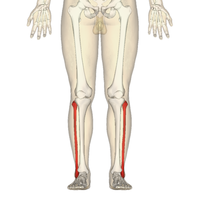
Photo from wikipedia
PURPOSE The purpose of this study was to characterize the morphological variations in the distal attachment of the popliteofibular ligament (PFL) and create an accurate classification for use in planning… Click to show full abstract
PURPOSE The purpose of this study was to characterize the morphological variations in the distal attachment of the popliteofibular ligament (PFL) and create an accurate classification for use in planning surgical procedures in this area and in evaluating radiological imaging. METHODS One hundred and thirty-seven lower limbs of body donors fixed in 10% formalin solution were examined for the presence and course of the popliteofibular ligament. RESULTS The PFL was present in 88.3% of cases. We propose the following three-fold classification: type I (72.3%), the most common type, characterized by the attachment onto the apex of the head of the fibula, type II (8.7%), characterized by a bifurcation, with the dominant band inserting on the anterior slope of the styloid process of the fibula and the smaller band onto the posterior surface of the styloid process of the fibula and type III (7.3%), characterized by a double PFL: the first PFL (main) originated from the popliteus tendon and inserted onto the anterior slope of the styloid process of the fibula, while the second originated from the musculotendinous junction of the popliteus muscle and inserted on the posterior surface of the styloid process of the fibula. CONCLUSION The PFL was characterized by high morphological variation, as reflected in our proposed classification. This variation may present clinical and biomechanical issues for both medical personnel and researchers. Our proposed classification may be valuable for clinicians who evaluate and perform surgical procedures within the knee joint area.
Journal Title: Clinical anatomy
Year Published: 2022
Link to full text (if available)
Share on Social Media: Sign Up to like & get
recommendations!